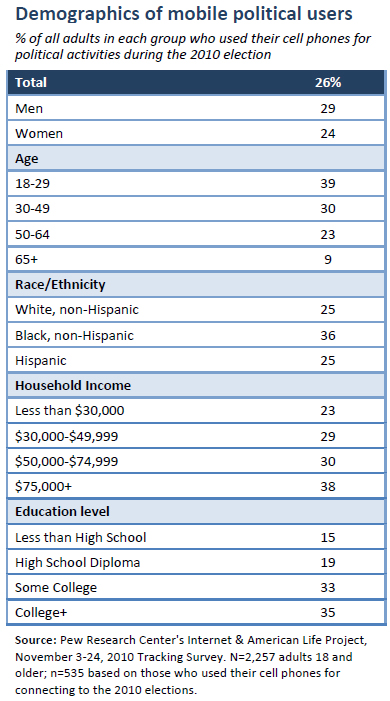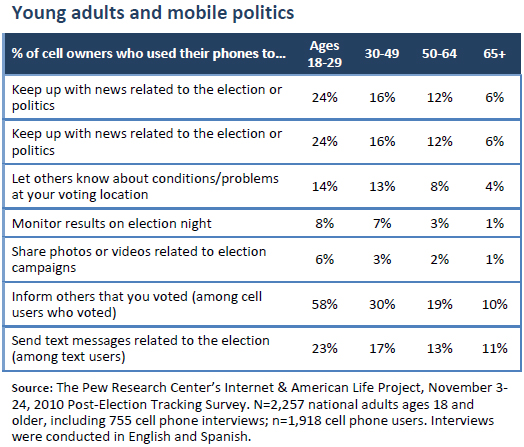More than a quarter of American adults – 26% – used their cell phones to learn about or participate in the 2010 mid-term election campaign.
In a post-election nationwide survey of adults, the Pew Research Center’s Internet & American Life Project found that 82% of adults have cell phones. Of those cell owners, 71% use their phone for texting and 39% use the phone for accessing the internet. With that as context, the Pew Internet survey found that:
- 14% of all American adults used their cell phones to tell others that they had voted.
- 12% of adults used their cell phones to keep up with news about the election or politics.
- 10% of adults sent text messages relating to the election to friends, family members and others.
- 6% of adults used their cells to let others know about conditions at their local voting stations on election day, including insights about delays, long lines, low turnout, or other issues.
- 4% of adults used their phones to monitor results of the election as they occurred.
- 3% of adults used their cells to shoot and share photos or videos related to the election.
- 1% of adults used a cell-phone app that provided updates from a candidate or group about election news.
- 1% of adults contributed money by text message to a candidate or group connected to the election like a party or interest group.
If a respondent said she or he had done any of those activities in the last campaign season, we counted that person in this 26% cohort. Throughout this report we call this group “mobile political users” or the “mobile political population.”
Some 71% of cell owners say they voted in the 2010 election, compared with 64% of the full adult population in this survey who say they voted. (Note: The overall reported turnout was about 40% in the election. It is common for post-election surveys to hear from a greater number of people who say they voted than was actually the case.) There was no partisan tilt in the makeup of the mobile political user population. They split their votes equally between Democratic and Republican congressional candidates – 44% to each. About 2% said they voted for other candidates and 10% didn’t answer the question or said they didn’t know. Generally, there were few partisan or ideological differences in way this group used their cell phones for politics.
In most cases, those ages 18-29 were more likely than those in older cohorts to use their cell phones for getting and sharing political information.
Introduction and overall findings
Cell phones have become an essential communications tool for American adults. Fully 82% of American adults say they have cell phones, and 71% of them use text messaging. Some 39% of cell owners also use their handheld devices to access the internet.
Mobile connectivity has become a growing feature in all kinds of communication and information exchanges—including politics—and mobile connectivity is becoming a regular feature of political campaigns. The Pew Research Center’s Internet & American Life Project tested the depths of this connection in the most recent campaign.
The results reported here come from a survey of 2,257 adults conducted November 3 through November 24, 2010. Among them, 1,918 are cell phone users. The margin of error in the cell-user sample is +/- 3 percentage points. The survey was conducted both on landline phones and cell phones and some 755 of the interviews were conducted on cell phones in this sample. This is the first time the Project has asked questions about use of cell phones in a mid-term election, so there are no comparable data for previous non-presidential elections. In 2008, we asked questions about texting and found that 29% of text messagers had traded texts with others or with candidates, their campaigns, or other groups.
This survey after the 2010 election found that more than a quarter of American adults – 26% – used their phones in one way or another to connect to the elections around the country:
- 14% of all American adults used their cell phones to tell others that they had voted. Some 71% of cell owners voted in the election, so that amounts to 27% of the mobile phone users who voted.
- 12% of adults used their cell phones to keep up with news about the election or politics. That amounts to 15% of cell-phone owners.
- 10% of adults sent text messages relating to the election to friends, family members and others. That means that 18% of those who use text messaging sent texts for these purposes.
- 6% of adults used their cells to let others know about conditions at their local voting stations on election day, including insights about delays, long lines, low turnout, or other issues. That means 10% of the cell owners who voted in the election used their mobile phones that way.
- 4% of adults used their phones to monitor results of the election as they occurred. That is 5% of cell owners.
- 3% of adults used their cells to shoot and share photos or videos related to the election. That is 4% of cell owners.
- 2% of adults used a cell-phone app that provided updates from a candidate or group about election news.
- 1% of adults contributed money by text message to a candidate or group connected to the election like a party or interest group.
The mobile political user group is more male than female, young than old, better off financially than less well-off, and better educated than less well-educated. African-Americans are also more likely than whites or Hispanics to be in this group – see the table below.

Those who used their cell phones for political purposes are a high-tech, high-activity group when it comes to using the internet: 92% of them have broadband at home vs. 60% of all adults; 72% own laptops vs. 53% of all adults; 66% own iPods or other MP3 players vs. 43% of all adults; 55% own gaming consoles vs. 38% of all adults; 9% own e-book readers; and 10% own iPads or another tablet computer. When it comes to general internet use, 81% of these mobile political users say they go online daily vs. 72% of all internet users; 72% of the mobile group use social networking sites like Facebook vs. 61% of all internet users; and 14% use Twitter vs. 8% of all internet users. They are also heavy users of all other functions on their cell phones such as getting email, sending texts and instant messages, and accessing the internet.
Mobile connectivity for politics is particularly popular among younger adults
As in many other domains for mobile connectivity, the use of cell phones for politics is particularly appealing to younger adults.

The partisan story
The wireless political user cohort does not tilt in a clear partisan direction. Republicans, Democrats and independents are equally likely to own cell phones and to be part of the mobile political user population. Some 44% of those in the mobile political user group voted for the Republican congressional candidate in the 2010 election; 44% voted for the Democratic candidate. Asked about their general partisan preference, 27% the wireless political user group say they are Republican; 35% say they are Democrats; and 32% describe themselves as independent. Those are roughly the same proportions as the overall population.
Ideologically, they also look much like the general population in this survey: 9% of wireless political users describe themselves as very conservative; 36% as conservative; 32% as moderate; 16% as liberal; and 4% as very liberal. Those percentages closely match the ideological distribution of the overall population.
The mobile political user group had divided views about the Tea Party movement: 34% said they agreed or strongly agreed with the Tea Party movement and 32% disagreed or strongly disagreed with the Tea Party movement. The rest had no opinion either way. These numbers are somewhat different from those in the general population. Among all adults, 30% strongly agreed or agreed with the Tea Party movement and 25% strongly disagreed or disagreed.
The mobile political users who disagreed with the Tea Party were more likely to use their cell phones to keep up with political news during the election season: 27% of the cell phone users who disagreed with the Tea Party used their cell phones to get campaign news, compared with 18% of the cell owners who agreed with the Tea Party. And on election night, 10% of cell owners who disagreed with the Tea Party used their phone to learn about election results; compared with 6% of those who agreed with the Tea Party.
Perhaps because Democratic partisans are somewhat younger as a group than Republican partisans there are a few areas in which those who voted for Democrats in the congressional elections in 2010 were more likely to use their cell phones for campaign-related activities. For instance, 26% of those who voted for congressional Democrats who are also text messagers said they sent texts about the election to others, compared with 19% of those who backed Republican congressional candidates who did that. In addition, 36% of the cell owners who supported Democrats said they used their cells to inform others that they had voted, compared with 24% of the Republican-supporters who used their cells that way.
Somewhat surprisingly, 21% of those who used their cell phones to learn about or participate in politics did not end up voting in the election. Some 35% of those in the survey said they did not vote, so the wireless political cohort went to the polls in greater numbers than the general population.